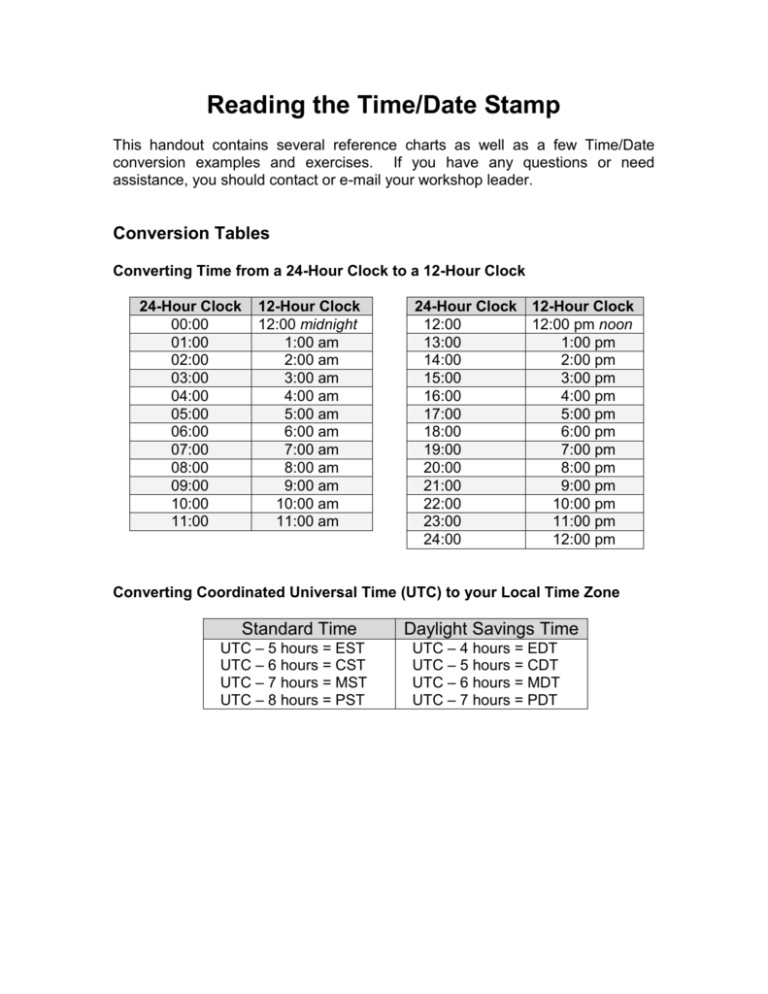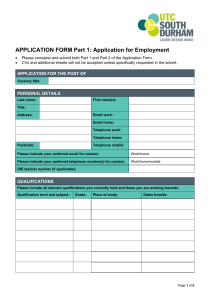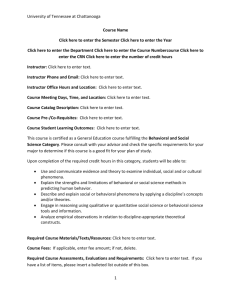Reading the Time/Date Stamp
advertisement

Reading the Time/Date Stamp This handout contains several reference charts as well as a few Time/Date conversion examples and exercises. If you have any questions or need assistance, you should contact or e-mail your workshop leader. Conversion Tables Converting Time from a 24-Hour Clock to a 12-Hour Clock 24-Hour Clock 00:00 01:00 02:00 03:00 04:00 05:00 06:00 07:00 08:00 09:00 10:00 11:00 12-Hour Clock 12:00 midnight 1:00 am 2:00 am 3:00 am 4:00 am 5:00 am 6:00 am 7:00 am 8:00 am 9:00 am 10:00 am 11:00 am 24-Hour Clock 12-Hour Clock 12:00 pm noon 12:00 13:00 1:00 pm 14:00 2:00 pm 15:00 3:00 pm 16:00 4:00 pm 17:00 5:00 pm 18:00 6:00 pm 19:00 7:00 pm 20:00 8:00 pm 21:00 9:00 pm 22:00 10:00 pm 23:00 11:00 pm 24:00 12:00 pm Converting Coordinated Universal Time (UTC) to your Local Time Zone Standard Time UTC – 5 hours = EST UTC – 6 hours = CST UTC – 7 hours = MST UTC – 8 hours = PST Daylight Savings Time UTC – 4 hours = EDT UTC – 5 hours = CDT UTC – 6 hours = MDT UTC – 7 hours = PDT Related Issues Time Zones Acronyms: It is important to remember to add or subtract an hour if it is Daylight Saving Time (Hawaii and parts of Arizona and Indiana do not use daylight saving time). Here are the acronyms referred to above. Standard Time Daylight Saving Time EST - Eastern Standard Time CST - Central Standard Time MST - Mountain Standard Time PST - Pacific Standard Time EDT - Eastern Daylight Time CDT - Central Daylight Time MDT - Mountain Daylight Time PDT - Pacific Daylight Time Time Zone Names: Coordinated Universal Time (UTC) is often expressed in three different ways: Greenwich Mean Time (GMT), Zulu (Z, this is also the American military time standard), and Universal Time (UT). In reality, all of these refer to slightly different time zones that differ only by a few seconds. For our purposes, they all refer to the same time zone. Time/Date Stamp Conversion Examples The following are two examples that illustrate how to read a Time/Date Stamp and how to determine the age of the data. Example 1: Time/Date Stamp: Current Time: Location: 12 DEC 00 07:00 UTC December 12, 2000 8:00 am Miami, FL 12 DEC 00 = December 12, 2000 UTC – 5 hours = EST 07:00 UTC – 5 hours = 02:00 EST 02:00 UTC = 2:00 am EST, therefore . . . Time and Date the data was recorded: 2:00 am December 12, 2000 Current Time – Recorded Time = Age of Data 8:00 am December 12, 2000 – 2:00 am December 12, 2000 = 0 days, 6 hours, 0 minutes Age of Data: 0 days, 6 hours, 0 minutes . Example 2: Time/Date Stamp: Current Time: Location: 14 JAN 01 18:45 GMT January 15, 2001 4:30 pm Hoboken, NJ 14 JAN 01 = January 14, 2001 GMT – 5 hours = EST 18:45 GMT – 5 hours = 13:45 EST 13:45 GMT = 1:45 pm EST, therefore . . . Time and Date the data was recorded: 1:45 pm January 14, 2001 . Current Time – Recorded Time = Age of Data 4:30 pm January 15, 2001 – 1:45 pm January 14, 2001 = 0 days, 26 hours, 45 minutes Age of Data: 1 day, 2 hours, 45 minutes . Converting Time/Date Stamps Practice Determine when that data was taken and the “age” of the data. Time/Date Stamp: 05 JAN 01 15:20 UTC Current Time: January 5, 2001 3:00 pm Location: Miami, FL Time and Date the data was recorded: ______________________________ Age of Data: ______________________________ 2. Time/Date Stamp: Current Time: Location: 31 DEC 00 05:20 GMT January 1, 2001 9:00 am Phoenix, AZ (Phoenix does NOT use Daylight Saving Time) Time and Date the data was recorded: ______________________________ Age of Data: ______________________________ 3. Time/Data Stamp: Current Time: Location: 22 JUL 00 22:30 Z July 25, 2000 11:30 pm Cleveland, OH Time and Date the data was recorded: ______________________________ Age of Data: ______________________________







